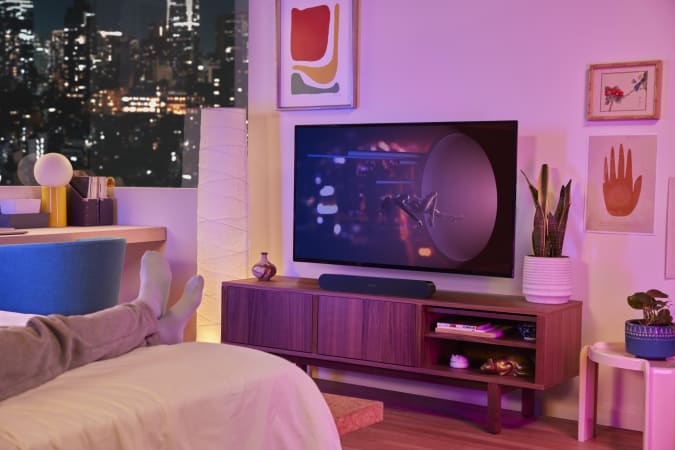Sonos products have never been cheap; in fact, the company raised prices on most of them last year. But Sonos has also recently released some products that push things into more affordable territory. Last year, the company released the $179 portable Sonos Roam speaker, and later followed up with a microphone-free version for $159, the cheapest Sonos yet. Home theater speakers, however, have remained premium products, with the $449 Beam being the cheapest soundbar option the company makes.
That changes today with the Ray, Sonos’ most compact and inexpensive soundbar, which arrives June 7th. At $279, it’s not competing on price with bargain options like Roku’s $130 Streambar. But in an advance demo earlier this week, it was clear that the Ray is a powerful soundbar that will provide a massive upgrade over just about any TV’s built-in speakers. Sonos made a few compromises to hit that $279 price point, but I think for a lot of people, it will make more sense than spending $449 on the Beam.
Like other Sonos speakers, the Ray connects to WiFi so you can stream audio to it from a range of popular services. You can group it with other Sonos speakers for multi-room playback and send songs to it via AirPlay 2 and Spotify Connect. Since it’s a soundbar, it connects to your TV with an optical cable to play whatever audio is coming through your television. And, like other Sonos soundbars, you can wirelessly pair the Ray with the Sonos Sub for extra bass, or a pair of Sonos One speakers for true rear surround sound. This last point makes it an ideal entry point into a Sonos home theater system that you can build up over time.

sound
To keep the price below $300, Sonos made some changes that it believes won’t be a major concern to its target audience. Since the Ray uses optical audio rather than HDMI, it has less audio bandwidth than the Beam and Arc soundbars. This means that the Ray is only capable of decoding Stereo PCM, Dolby Digital and DTS Digital Surround; it’s incompatible with Dolby Atmos, a major difference from Sonos’ other home theater products. It does keep an ethernet port for faster networking performance, though.
Sonos also skipped out on including a microphone here, so you can’t use it directly with the new Sonos Voice Control feature or other assistants like Alexa and Google Assistant. In addition, the Ray has simpler speaker internals than what you’ll find on the Beam and Arc. All told, you get two center midwoofers, two tweeters with split waveguides to broaden the speaker’s soundstage, a bass reflex system that provides a surprising amount of low-end performance, and four Class-D amplifiers.

sound
The speaker has a tapered design and forward-facing speaker components, unlike the Beam and Arc. Sonos says this is so you can tuck the Ray inside of a media stand without sound bouncing off the walls. This is part of the overall vision for a product built for smaller spaces than other Sonos soundbars, which are both large and loud. (As usual with Sonos products, it comes in both black and white, either of which should look just fine in a wide variety of homes.)
Naturally, the Ray’s speaker setup is more modest than more expensive Sonos speakers, but in practice it still provides an impressively well-balanced listening experience, whether it be music or movies. Sonos said that it focused on areas where it felt built-in TV speakers were particularly lacking, like dialog reproduction and bass. Both of those characteristics were definitely noticeable in the demo. Naturally, we’ll need to do some closer listening to see how it compares to other soundbars from Sonos as well as its competitors, but the Ray made a positive first impression. Like other Sonos speakers, too, you can use an iOS device to enable Trueplay speaker-tuning technology to optimize the Ray’s sound for your specific environment.
At first glance, it seems the Ray offers a lot of value for $279. In some ways, Sonos is positioning it as the “gateway drug” for its home theater lineup, similar to how the Roam serves as an entry into the Sonos ecosystem. Like the Roam, the Ray costs more than some competing products, but that cost gets you a full-fledged Sonos device with all the benefits that entails, including a focus on audio quality. You could definitely get a less expensive soundbar, but Sonos isn’t trying to be the cheapest by any means necessary. Instead, it’s trying to bring the power and clarity of its other soundbars to a smaller, more affordable package. How successful it’ll be remains to be seen, but at first listen the Ray could attract a lot of people interested in something like the Sonos Beam, but who were otherwise scared off by its price.
All products recommended by Engadget are selected by our editorial team, independent of our parent company. Some of our stories include affiliate links. If you buy something through one of these links, we may earn an affiliate commission.
